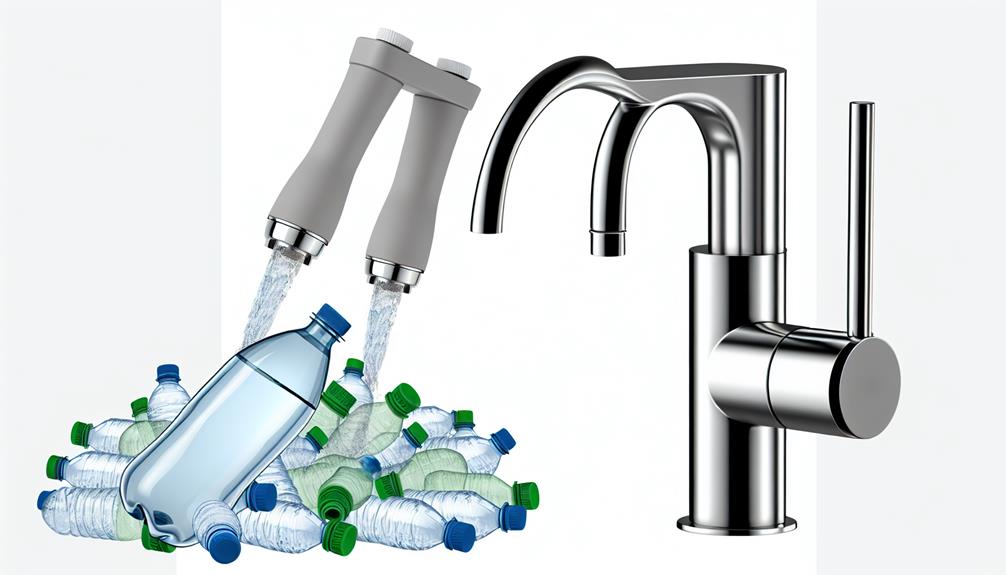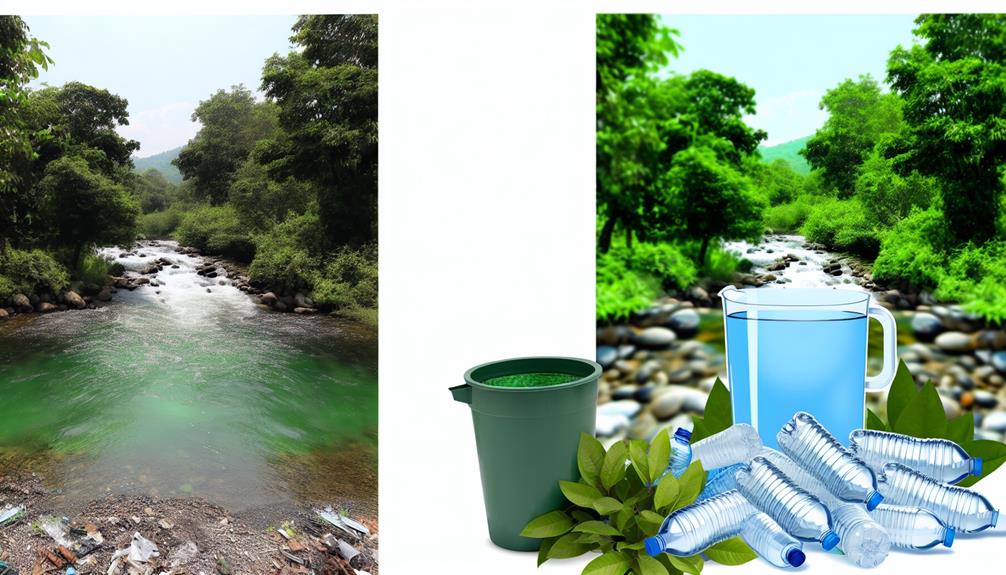Just as you're considering the clean glass of water in your hand, you may not realize the complex journey it's undergone through various purification techniques before reaching you. These processes, essential for providing safe drinking water, can have profound implications for the environment.
As you're aware, the health of ecosystems is intricately linked to the quality of water within them, and the methods used to purify this vital resource can tip the balance in subtle yet significant ways.
You'll find that understanding the interplay between purification practices and ecological well-being isn't just about appreciating the hidden life of a drop of water; it's about grasping a larger narrative where every action has a reaction, and where the technology designed to protect us might sometimes pose risks to the natural world.
Let's consider the potential consequences, both beneficial and harmful, that these techniques may harbor for the intricate tapestry of life that relies on our planet's waterways.
Purification Methods Overview
Several purification techniques, including activated carbon filters and reverse osmosis systems, effectively eliminate a wide array of contaminants from water, ensuring its safety for consumption. Activated carbon filters are adept at removing chlorine, sediment, and volatile organic compounds, which can significantly improve both the taste and water quality. These filters work by adsorbing impurities onto the surface of the activated carbon, thus eliminating them from the water.
Reverse osmosis systems, on the other hand, provide a more comprehensive solution by removing up to 99% of contaminants. This high level of purification is achieved by forcing water through a semipermeable membrane, which blocks impurities while allowing clean water to pass through. Reverse osmosis systems are particularly effective in removing contaminants like salts, minerals, and other dissolved substances.
Other filtration technologies contribute to conserving water and enhancing its quality. For instance, UV purification systems destroy harmful microorganisms by exposing them to ultraviolet light, without the need for added chemicals. Ceramic filters, known for their fine pores, are also highly effective in removing bacteria and sediment.
Each of these filtration systems offers distinct advantages, playing a crucial role in purifying drinking water and thereby protecting ecosystem health.
Aquatic Life and Filtration
While various filtration systems enhance drinking water quality, it's essential to consider how these technologies impact aquatic life and the health of water ecosystems. Activated carbon filters, which remove chlorine and volatile organic compounds, may inadvertently affect marine life by altering water chemistry. These changes can disrupt the ecological balance, potentially harming sensitive aquatic species.
Moreover, reverse osmosis systems, praised for providing safe drinking water by eliminating up to 99% of contaminants, may also strip water of beneficial minerals. This demineralized water, if discharged back into water resources, can alter the osmotic balance crucial for the survival of many aquatic organisms.
UV purification technologies offer a chemical-free approach to destroying harmful microorganisms, ensuring water safety without introducing new contaminants into aquatic ecosystems. However, it's imperative to manage the disposal of UV system components, as improper disposal can lead to environmental pollution.
Ceramic filters excel at removing bacteria and sediment, but the accumulation and disposal of captured contaminants must be carefully managed to prevent harm to water ecosystems.
You must recognize that each water treatment technology carries potential side effects for aquatic life. It's vital to continuously improve purification technologies to minimize their ecological footprint while providing access to clean water.
Chemical Runoff Concerns
Frequently, the chemical runoff stemming from widespread agricultural and industrial practices contaminates our waterways, posing a significant threat to both aquatic ecosystems and human health. As you delve into the intricacies of chemical runoff concerns, it's crucial to understand the gravity of this issue.
- Chemical runoff can carry harmful substances into freshwater resources, disrupting the delicate balance necessary for diverse species to thrive.
- The environmental impact of plastic further exacerbates water scarcity, as microplastics add to the array of pollutants.
- Contaminants from water, including pesticides and industrial waste, have been linked to health problems in humans and wildlife.
- Water purification systems play a pivotal role in removing common contaminants, yet they face challenges with the sheer volume and variety of pollutants.
- Sustainable development necessitates the reduction of chemical runoff to protect our finite water supplies and ensure ecosystem vitality.
Your awareness of these challenges is imperative. The presence of harmful contaminants in water supplies demands rigorous attention. Implementing stringent regulations and innovative water purification systems isn't just a technical necessity but a moral imperative. As stewards of the environment, the responsibility for mitigating chemical runoff concerns and fostering sustainable development rests on your shoulders.
Filtration Technology Evolution
Recognizing the severity of chemical runoff, it's essential to explore how advancements in filtration technology have bolstered our ability to provide cleaner, safer water. Water purification systems have evolved significantly, incorporating sustainable technologies that align with environmental goals.
Reverse osmosis (RO) systems, for instance, have become a cornerstone in water purification, utilizing a semi-permeable membrane to remove up to 99% of waterborne contaminants. This process ensures that the water you consume is free from a wide spectrum of impurities, playing a crucial role in environmental protection.
The filters used in various systems each contribute uniquely to the overall impact on the environment. Activated carbon filters excel in extracting chlorine, sediment, and volatile organic compounds, while ceramic filters are highly effective against bacteria and sediment. Moreover, UV purification systems provide a chemical-free method to destroy harmful microorganisms, ensuring that the water purification process doesn't introduce additional pollutants.
Together, these technologies reflect a commitment to not only supply safe drinking water but also to safeguard ecosystem health. By adopting these advanced filtration methods, systems provide a dual benefit: they meet human needs and support the vitality of the natural world.
Ecosystem Recovery Case Studies
Examining case studies of ecosystem recovery reveals that the implementation of Advanced Air Purification Technology (AAPT) in Long-Term Care Facilities (LTCFs) has led to a marked improvement in environmental health, showcasing a 98.83% reduction in airborne pathogens. This significant decline is attributed to AAPT's efficacy in remediating volatile organic compounds (VOCs) and airborne pathogens, which not only enhances the clinical outcomes for residents but also contributes to a healthier ecosystem within these facilities.
The role of water purification systems in such scenarios can't be understated. These systems contribute to ensuring clean and safe environments, providing clean resources, and reducing the ecological footprint of healthcare facilities. Here is how the methods and systems contribute to ecosystem health:
- *Ensure access to clean drinking water, vital for both human health and wildlife.*
- *Contribute to sustainable water use, crucial in maintaining ecological balance.*
- *Reduce the release of harmful chemicals into the environment.*
- *Support the resilience of local ecosystems by preventing waterborne diseases.*
- *Demonstrate the effectiveness of integrating environmental technologies in healthcare settings.*
These ecosystem recovery case studies underscore the importance of incorporating both air and water purification methods in LTCFs, underlining the pivotal role they play in providing clean, safe, and sustainable environments.

